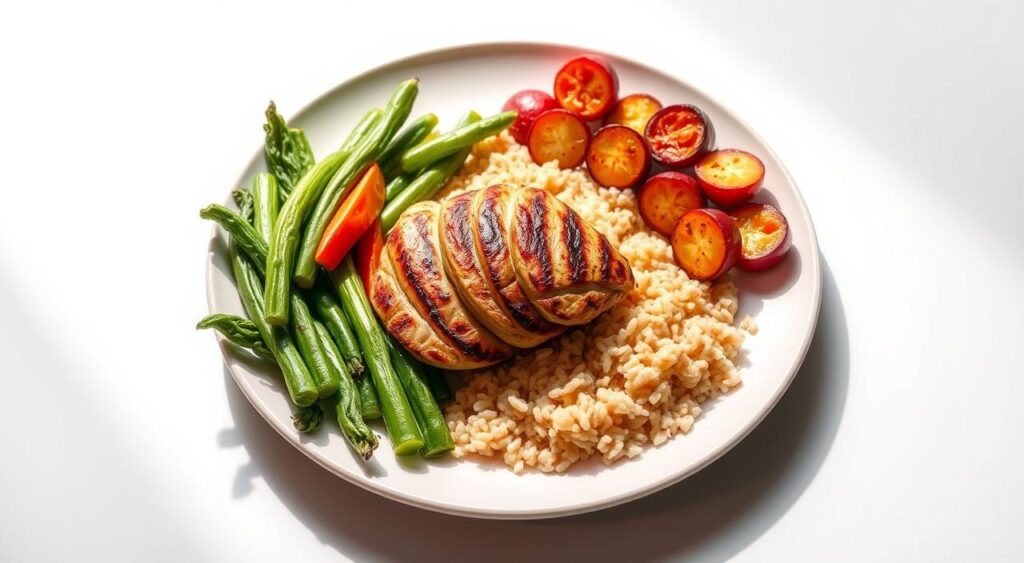Managing diabetes can be challenging, but with the right approach to nutrition, it becomes more manageable. Controlling carbohydrate intake is crucial for maintaining stable blood sugar levels.
You can simplify healthy eating by incorporating delicious and nutritious meals into your daily routine. The Diabetes Plate Method is a useful tool for planning balanced meals that support overall health.
By focusing on key nutrients and making smart substitutions, you can enjoy a variety of diabetes-friendly foods. Discover how to make healthy eating both simple and enjoyable with our comprehensive guide.
Key Takeaways
- Simplify meal planning with the Diabetes Plate Method
- Focus on key nutrients for diabetes management
- Make smart substitutions for healthier eating
- Enjoy a variety of diabetes-friendly foods
- Maintain stable blood sugar levels with balanced meals
Why Low Carb Eating Matters for Diabetes Management
Low carb eating has emerged as a significant strategy for managing diabetes, offering numerous benefits for overall health. When you consume carbs, they break down into glucose, causing your blood sugar to rise. The rate and extent of this rise depend on the type and amount of carbs you consume.Managing carb intake is essential for people with diabetesas it directly impacts blood sugar levels.
Focusing on complex carbohydrates with fiber can help you digest more slowly, causing less dramatic blood sugar spikes. Research shows that reducing carb intake can lead to improved glycemic control, reduced medication needs, and better weight management for many people with diabetes. The American Diabetes Association recognizes that low carb eating patterns can be effective for diabetes management, though the optimal carb intake varies by individual.

Understanding the difference between total carbs and net carbs (total carbs minus fiber) is crucial when planning your meals for diabetes management. By tracking your personal response to different carb amounts and types, you can determine your optimal carb intake for blood sugar stability. This approach helps you address insulin resistance, a key factor in type 2 diabetes, and supports overall metabolic health.
The Diabetes Plate Method: Balancing Your Meals
You can balance your meals effectively with the Diabetes Plate Method, a simple visual guide created by the American Diabetes Association. This method helps you portion your meals without measuring or counting. To apply it, fill half your plate with non-starchy vegetables like leafy greens, broccoli, and peppers.
Allocate one quarter of your plate to lean protein sources such as chicken, fish, or plant-based proteins. The remaining one quarter should be carbohydrate foods, focusing on high-fiber, nutrient-dense options. This approach naturally limits carbs while ensuring nutritional balance.

Key Nutrients to Prioritize in Your Diabetic Diet
To maintain optimal health with diabetes, it’s vital to focus on consuming key nutrients that support blood sugar control and overall health. Fiber is crucial, as it slows carbohydrate digestion and improves blood sugar control. Aim for 25-30 grams daily from vegetables, fruits, whole grains, and legumes.
| Nutrient | Benefits | Food Sources |
|---|---|---|
| Fiber | Slows carbohydrate digestion, improves blood sugar control | Vegetables, fruits, whole grains, legumes |
| Healthy Fats | Provides satiety, supports heart health | Olive oil, avocados, nuts, fatty fish |
| Magnesium | Supports glucose metabolism, insulin sensitivity | Dark leafy greens, nuts, seeds, whole grains |
In addition to fiber, other essential nutrients include healthy fats, high-quality proteins, magnesium, chromium, antioxidants, vitamin D, calcium, potassium, prebiotics, and probiotics. Incorporating these nutrients into your diet can help manage diabetes and support overall well-being. 
Delicious Low Carb Meals for Diabetics
Discover the joy of cooking delicious low-carb meals that cater to your diabetic needs. You can try a classic favorite or discover something new – all designed to keep your diabetes in check.
Breakfast Options to Start Your Day Right
Starting your day with a balanced, low-carb breakfast sets the tone for stable blood sugar throughout the day. Consider Greek yogurt parfaits with berries, nuts, and a sprinkle of cinnamon, or veggie-packed omelets made with eggs and colorful vegetables. These options combine protein, healthy fats, and limited carbohydrates, keeping you full for hours.
Lunch Ideas That Keep You Satisfied
For lunch, build meals around non-starchy vegetables and lean proteins to maintain energy without afternoon blood sugar crashes. You can opt for mason jar salads with a protein source, plenty of veggies, and a small amount of healthy carbs like quinoa, or lettuce wraps filled with tuna, chicken, or turkey. These meals are not only delicious but also portable and convenient.

- Repurpose leftovers from dinner into quick and easy lunches, adjusting portions to maintain the diabetes plate method balance.
- Add a small serving of low-glycemic fruit or a few whole grain crackers to your lunch to satisfy carb cravings without causing significant blood sugar spikes.
- Prepare several breakfast and lunch options at once to ensure you always have diabetes-friendly choices available when hunger strikes.
Protein-Rich Dinner Recipes for Blood Sugar Control
Protein-rich dinner recipes are an excellent option for diabetics looking to control their blood sugar levels. These dinners not only help manage glucose levels but also provide satiety and support muscle maintenance.
Two delicious and healthy dinner ideas are our Cajun-inspired jambalaya and simple salmon burgers, both of which are carefully crafted to be low in carbs and rich in nutrients.
Cajun-Inspired Jambalaya with Cauliflower Rice
This creative twist on a classic dish replaces traditional rice with cauliflower rice, significantly reducing the carb content. The jambalaya is packed with spicy Spanish sausage, sweet peppers, and tomatoes, making it a flavorful and nutritious option. With a star rating of 4.8 out of 5 from 2846 ratings, it’s a recipe you can trust.
Simple Salmon Burgers with Ginger and Soy
For a lighter option, our salmon burgers are made with salmon rich in omega-3 fatty acids, ginger, and soy sauce. The addition of ginger not only enhances the flavor but also provides potential blood sugar-lowering effects. These burgers have received a 4.6 out of 5 rating from 394 reviews, making them a popular choice.
Hearty Soups and Stews for Diabetic Diets
Soups and stews offer a comforting and nutritious option for diabetics looking to control their carb intake. These dishes are not only filling but also packed with nutrients, making them an excellent choice for diabetes management.
Two delicious and healthy options are our Low-Fat Celery Soup and Spicy Lentil and Vegetable Stew. The Low-Fat Celery Soup has a star rating of 4.8 out of 5 from 895 ratings, while the Spicy Lentil and Vegetable Stew has a rating of 4.6 out of 5 from 1462 ratings.
Low-Fat Celery Soup
This soup is a light and satisfying option, perfect for a healthy veggie lunch or supper. With a high water content, it helps with portion control and hydration, making it gentle on blood sugar levels. Serve with chunks of crusty bread for a filling meal.
Spicy Lentil and Vegetable Stew
This stew is a delicious, spicy blend packed with iron and low in fat. It’s ready in under half an hour or can be made in a slow cooker, offering flexibility. The lentils provide plant-based protein and fiber, helping to slow digestion and prevent blood sugar spikes.
Both recipes are ideal for meal prep as they can be made in large batches and frozen in individual portions. Adding extra non-starchy vegetables increases the nutrient density and fiber content while keeping carbohydrates in check. You can also top these soups with a dollop of Greek yogurt or serve with a side of lean protein for added protein.
Vegetable-Forward Dishes to Boost Nutrition
Incorporating vegetable-forward dishes into your meal plan can be a game-changer for diabetes management. By focusing on vegetables, you can create meals that are not only delicious but also rich in fiber, vitamins, and minerals, while being low in carbohydrates.
Vegetable-centered recipes are ideal for diabetes management as they’re naturally low in carbs and rich in nutrients. Two standout dishes that showcase the versatility of vegetables are chargrilled vegetables with buffalo mozzarella and caramelized carrots with herbs.
Chargrilled Vegetables with Buffalo Mozzarella
This recipe combines the smoky flavor of grilled vegetables with the creamy richness of cheese, making for a satisfying dish that won’t spike blood sugar. Serving this with torn buffalo mozzarella adds protein and calcium while keeping the serving low in carbs.
Caramelized Carrots with Herbs
This recipe highlights how cooking techniques can transform everyday veggies into special dishes. The natural sweetness of carrots is enhanced through caramelization, satisfying sweet cravings without added sugars that would impact blood glucose. A serving of this dish is not only delicious but also nutritious.
Both of these recipes demonstrate how vegetables can be the star of the meal, helping increase your overall vegetable consumption. By making vegetables the centerpiece of your meals, you can better manage your diabetes while enjoying flavorful and nutritious food.
Smart Carb Substitutions for Traditional Favorites
You can enjoy your favorite dishes while managing diabetes with the right carb swaps. Making smart carb substitutions allows you to indulge in familiar flavors and textures while maintaining better blood sugar control.
Cauliflower Rice Alternatives
Cauliflower rice has become a popular rice substitute, containing approximately 5g of carbs per cup compared to white rice’s 45g. You can prepare it by pulsing fresh cauliflower in a food processor or purchase it pre-riced. It works well in stir-fries, as a base for curries, or as a side dish seasoned with herbs and spices.
Zucchini Noodles for Pasta Dishes
Zucchini noodles, or “zoodles,” provide a pasta-like experience with significantly fewer carbohydrates. A spiralizer can transform zucchini into noodles, or you can find pre-spiralized options in stores. Enjoy them raw, lightly sautéed, or quickly blanched. They work well with virtually any pasta sauce, giving you versatility while keeping carbs in check.
- Cauliflower rice and zucchini noodles are excellent low-carb alternatives to traditional high-carb foods.
- Other smart substitutions include lettuce wraps, portobello mushroom caps, and spaghetti squash.
- These alternatives allow you to enjoy your favorite dishes while maintaining better blood sugar control.
Beyond cauliflower and zucchini, exploring other low-carb options can add variety to your diabetic diet. By incorporating these smart carb substitutions, you can enjoy a more flexible and satisfying eating experience.
One-Pot Meals for Easy Weeknight Cooking
One-pot meals are a great way to simplify cooking while maintaining control over the ingredients and carbs. These meals are ideal for busy individuals managing diabetes, as they allow for complete control over the nutritional content.
Two delicious and easy-to-make options are Chicken Jalfrezi with Vegetables and Post-Holiday Curry with Leftovers.
Chicken Jalfrezi with Vegetables
This flavorful dish is packed with veggies and spices, making it a great diabetes-friendly alternative to takeout. Ready in about 30 minutes, it’s a quick and easy recipe that incorporates multiple non-starchy veggies.
Post-Holiday Curry with Leftovers
This recipe is a great way to repurpose protein-rich holiday foods into a new meal, preventing food waste while maintaining blood sugar control. Simply add your favorite chicken and sauce to create a delicious and satisfying serving.
International Flavors: Low Carb Global Cuisine
You can add excitement to your meal planning by incorporating low-carb international recipes. Exploring global cuisines can introduce you to a variety of flavors and ingredients that not only tantalize your taste buds but also support diabetes management.
Mediterranean Diet-Inspired Dishes
The Mediterranean diet is renowned for its health benefits, emphasizing olive oil, fish, vegetables, and moderate carbohydrate intake. You can enjoy Greek salads with feta, olives, cucumbers, and tomatoes dressed with olive oil, providing a complete low-carb meal rich in beneficial fats and antioxidants. Italian cuisine can also be adapted by focusing on dishes like chicken cacciatore with tomato sauce served over zucchini noodles.
Asian-Influenced Low Carb Recipes
Asian-influenced low-carb recipes often feature ingredients like ginger, garlic, and turmeric, which may have modest blood sugar-lowering effects. You can make salmon teriyaki using a small amount of reduced-sugar teriyaki sauce and serving it with steamed bok choy instead of rice. Stir-fries with abundant vegetables and moderate protein served over cauliflower rice dramatically reduce the carbohydrate content while maintaining satisfaction.
By exploring these international flavors, you can prevent diet boredom and introduce a wider range of nutrients and beneficial plant compounds that support overall health with diabetes. Incorporating these recipes into your meal plan can make managing your diabetes easier and more enjoyable.
Quick and Healthy Snacks for Blood Sugar Stability
Maintaining stable blood sugar levels is crucial for diabetics, and strategic snacking plays a significant role in achieving this goal. The ideal snack combines protein and/or fat with a small amount of complex carbs to provide sustained energy.
Healthy options include hard-boiled eggs, celery sticks with almond butter, and a small handful of veggies or nuts. You can also try Greek yogurt topped with berries or cheese sticks paired with cucumber slices.
- Zucchini chips made by baking thinly sliced zucchini are a great low-carb alternative to potato chips.
- Avocado halves sprinkled with everything bagel seasoning offer healthy fats that support heart health.
Guilt-Free Desserts for Diabetic Sweet Cravings
Enjoying sweet treats while managing diabetes is possible with the right choices. You can indulge in desserts that are not only delicious but also mindful of your dietary needs.
Baked Fruit Desserts
Baked fruit desserts, such as cinnamon-spiced baked apples or pears, are a great option. They concentrate the natural sweetness of the fruit without adding sugars, making them a smart recipe choice for occasional treats. A serving of baked fruit can be a satisfying dessert.
Low-Sugar Treats
For those with a chocolate craving, desserts like zucchini brownies or avocado chocolate mousse are healthier alternatives. They use vegetable puree to replace some fat and sugar, reducing the carb count. This version of a classic dessert is not only lower in carbs but also rich in healthy fats and fiber, making it a nutritious food choice.
| Dessert | Carb Count | Serving Size |
|---|---|---|
| Baked Apples | 15g | 1 medium apple |
| Zucchini Brownies | 10g | 1 square |
| Avocado Chocolate Mousse | 8g | 1/2 cup |
Meal Planning and Prep for Diabetic Diets
To manage diabetes effectively, it’s essential to plan your meals carefully. Effective meal planning helps maintain consistent carbohydrate intake and prevents impulsive food choices that can derail blood sugar control.
Start by planning a week’s worth of meals that follow the diabetes plate method, ensuring balanced nutrition while controlling carbohydrate content at each meal. Create a detailed shopping list organized by grocery store sections to streamline shopping and ensure you have all necessary ingredients for your planned meals.
Dedicate time weekly for meal preparation, such as washing and chopping vegetables, cooking proteins, and preparing complex components that can be assembled quickly on busy days. Invest in quality food storage containers that allow you to portion meals according to your carbohydrate needs and make grab-and-go options readily available.
| Meal Component | Carb Content | Serving Size |
|---|---|---|
| Grilled Chicken | 0g | 3 oz |
| Cauliflower Rice | 5g | 1 cup |
| Steamed Broccoli | 5g | 1 cup |
Consider preparing “meal component” rather than complete meals – having cooked proteins, prepared vegetables, and portioned carbohydrates allows for mixing and matching throughout the week. Track the carbohydrate content of your prepared meals and snacks, labeling containers if necessary to simplify carb counting and insulin dosing if applicable.
Incorporate variety in your meal plan to prevent diet fatigue while ensuring you get a wide range of nutrients – aim for different colored vegetables and various protein sources throughout the week. With practice, successful meal planning becomes easier and can dramatically improve blood sugar management while reducing the stress of daily food decisions.
Navigating Food Labels with Diabetes in Mind
When managing diabetes, understanding how to read food labels is crucial for making informed dietary choices. This skill helps you navigate the complex world of food options and make decisions that support your health goals.
To effectively read food labels, start by checking the serving size, as all nutritional information is based on this amount. Many packages contain multiple servings, which can lead to unintentional carbohydrate overconsumption if you’re not careful.
- Focus on total carbohydrates rather than just sugar, as all carbohydrates (except fiber) eventually convert to glucose and affect blood sugar levels.
- Calculate net carbs by subtracting dietary fiber from total carbohydrates to get a more accurate picture of the carbohydrates that will impact blood glucose.
- Be aware of sugar alcohols in “sugar-free” products, as they can still affect blood glucose levels and may cause digestive issues in some people.
It’s also important to check the ingredients list for hidden sugars, which may appear under various names like dextrose, maltose, or high fructose corn syrup. Consider the protein and fat content alongside carbohydrates, as these nutrients can help slow glucose absorption and contribute to satiety.
Be cautious with “diabetic” food products, which are often expensive and may not offer significant advantages over carefully chosen regular foods. Remember that whole, unprocessed foods without labels, such as fresh vegetables, meats, and eggs, are generally excellent choices for diabetes management.
Restaurant Strategies: Eating Out with Diabetes
With a little planning, you can savor your favorite restaurant meals while keeping your diabetes in check. To make the most of your dining experience, start by researching the restaurant’s menu online before you arrive at the table. This allows you to identify healthy options and plan your meal in advance, reducing the likelihood of impulsive choices.
When you’re seated at the table, don’t hesitate to ask questions about how your food is prepared. Inquire about hidden carbs in sauces or marinades that could affect your blood sugar levels. You can also request modifications to make your dish more diabetes-friendly, such as substituting extra vegetables for starchy sides or asking for sauces on the side.
Consider starting your meal with a non-starchy vegetable appetizer or salad to take the edge off your hunger. Apply the plate method by visually dividing your plate into sections for vegetables, protein, and starch, even if the serving sizes don’t match these proportions. Be mindful of serving sizes, which are often larger at restaurants, and consider sharing entrees or taking some home.
Staying hydrated with water rather than sugary drinks is also crucial. Be cautious with alcohol, as it can cause blood sugar fluctuations. Remember, one meal won’t make or break your diabetes management; focus on making the best choices available and return to your regular eating pattern at the next meal. By being mindful of your choices when dining out with people, you can enjoy social dining experiences while maintaining control over your diabetes.
Conclusion: Making Low Carb Living Sustainable with Diabetes
Sustainable diabetes management is achievable through consistent low carb eating habits. By focusing on progress rather than perfection, you can maintain a low carb approach while allowing for flexibility on special occasions.
Building a repertoire of your favorite low carb recipes and meal ideas makes healthy eating enjoyable. Connecting with others who follow similar eating patterns can provide valuable support and inspiration.
With the right approach, low carb living with diabetes becomes second nature, supporting your health while allowing you to enjoy delicious meals. Regularly reassessing your approach and incorporating physical activity will help you achieve optimal blood sugar management.
FAQ
What are some healthy protein sources for diabetics?
You can include protein-rich foods like chicken, salmon, eggs, and lentils in your diet to help manage blood sugar levels.
How can I substitute high-carb ingredients in my favorite recipes?
You can replace traditional pasta with zucchini noodles or use cauliflower rice instead of regular rice to reduce carb intake.
What are some delicious and healthy breakfast options for diabetics?
You can start your day with breakfast dishes featuring eggs, vegetables, and cheese, such as omelets or frittatas.
Can I still enjoy international cuisine while managing diabetes?
Yes, you can adapt international flavors to your diabetic diet by making smart ingredient substitutions and choosing dishes with vegetables and lean protein sources.
How can I plan and prepare healthy meals in advance?
You can set aside time to plan your meals, make a grocery list, and prep ingredients in advance to ensure you’re eating healthy, balanced meals.
What are some tips for navigating food labels when you have diabetes?
When shopping, be sure to read labels carefully, checking the ingredient list and nutrition facts to make informed choices about the foods you eat.
How can I eat out while managing my diabetes?
You can make healthy choices when eating out by selecting dishes with vegetables, lean protein, and whole grains, and by asking for modifications to suit your dietary needs.
What are some healthy snack options for diabetics?
You can satisfy your cravings with healthy snacks like veggies with hummus, hard-boiled eggs, or a piece of fresh fruit.



